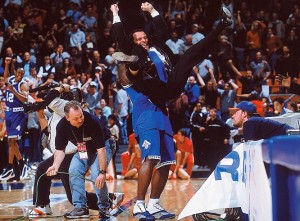20 Questions: Why is Georgetown So Incapable of March Success?
Posted by Bennet Hayes on October 23rd, 2013Throughout the preseason, RTC national columnists will answer the 20 most compelling questions heading into the 2013-14 season. Previous columns in this year’s series are located here.
The moment came long before the seismic final flourish. Chase Fieler may have slammed the door shut on Georgetown’s March dreams when he pumped through that Brett Comer lob, but the sniff of NCAA Tournament doom – a sensation that is fast becoming a Georgetown supporter’s sixth sense – surely set in far sooner. These days it doesn’t take much to elicit that sense of fear in Georgetown circles come March, as double-digit seeds have sent the Hoyas home before the Sweet Sixteen in each of their last five NCAA Tournaments. The futility has been so profound that Hoya fans can likely find a bit of retroactive appreciation for the most underachieving Georgetown team of the last decade: a 2009 squad littered with talent (Greg Monroe, DaJuan Summers, Chris Wright and Austin Freeman, among others) that bottomed out in the first round of a tournament that lacks the power to break hearts – the NIT. With the halcyon days of a 2007 Final Four run now firmly in the rear view mirror and a confused hysteria building with every March failure, “Hoya Paranoia” has taken on an entirely different meaning. So naturally, we ask the question: Why is Georgetown so incapable of March success?

To Say March Success Has Eluded John Thompson III And Georgetown Lately Would Be An Understatement (AP images)
At this point, even the most forgiving of Georgetown supporters would have to admit that some part of the Hoyas’ problem comes from within. Five straight March disappointments is plenty large enough a sample size to sound the alarms. John Thompson III’s system, highlighted by a slow-tempo offense that rarely deviates from Princeton sets, is also unique enough stylistically to raise concerns that the program may be resting on a fundamentally damaged foundation. Nobody should be willing to take that theory all the way, as slow-tempo teams have found plenty of March success over the years (75 percent of the 2013 Final Four ranked in the bottom 40 percent in possessions per game), but limiting possessions is an easy way to give a team with decidedly inferior talent a chance to win. It’s the same reason why underdogs will find winning one game easier than taking down a seven-game series, and just last season we saw Georgetown keep plenty of bad teams hanging around into the final minutes. Duquesne, Liberty, and Towson all ended the season outside the top 170 teams in the country (according to KenPom), but each lost by single figures to a Hoya team that would finish 301st in the country in possessions per game. That slow tempo is par for the course for Thompson-coached Hoya outfits; after finishing 70th nationally in possessions per game in Craig Esherick’s final year in 2004, the Hoyas have not ranked higher than 188th since. Let’s be real: This preference for a snail’s pace is not a sufficient answer to the question as a stand-alone, but the Hoyas rarely blow teams out (relative to other highly-seeded teams) and struggle to come back when they fall behind early – see 2010 (Ohio), 2011 (VCU), 2013 (FGCU) for some recent examples.












































